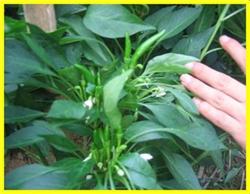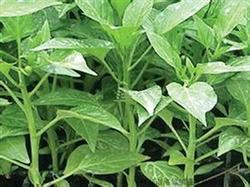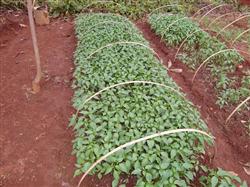Efficient multiple cropping of winter lettuce and early spring pepper in greenhouse

Lettuce is a variety of lettuce with disease resistance, high yield and cold tolerance. Sowing and raising seedlings in a small arch shed from late August to late September. After sowing, the greenhouse film should be ventilated and covered with sunshade net to reduce the temperature during the day, and the greenhouse film should be covered when it rains at night. From seedling division to slow seedling stage, shade is needed during the day to create an environmental temperature suitable for the growth of lettuce. Try to control watering, no drought, no watering, in order to prevent seedlings from overgrowing. The seedlings were planted in the greenhouse at the age of 35 days. 5000 kg of mature organic fertilizer and 50 kg of ternary compound fertilizer were applied per mu, and the soil was prepared to make beds, with a row spacing of 50 cm, a plant spacing of 35 cm, and about 3500 plants per mu. Water immediately after planting. In the slow seedling stage, the greenhouse temperature was ventilated when the temperature was more than 20 ℃, keeping the temperature in the greenhouse no more than 25 ℃ during the day and 10 ℃ at night. After the temperature dropped, grass curtain was added to keep warm before and after the Beginning of Winter, and double film and double mulch were adopted when the temperature was low. In fertilizer management, the method of light application of seedling fertilizer and heavy application of opening fertilizer was adopted. Pay attention to the prevention and control of downy mildew, Sclerotinia sclerotiorum, soft rot and other diseases. Control downy mildew with 64% poisonous alum, 1000 times of sclerotiorum and 1300 times of neophytomycin or 72% agricultural streptomycin to control soft rot. The pepper variety Haifeng 68 with high yield and disease resistance was selected. Sowing and raising seedlings in the greenhouse from late October to early November. During the period of seedling raising, double film mulching and double layer grass mulch were adopted to keep warm. The seedlings were divided into 3 leaves and 1 heart stage, and were planted when buds appeared, and the seedling age was about 100 days. After lettuce was harvested, the soil was prepared to fertilize and make beds in time. 2. In the first and middle of the month, the temperature in the greenhouse was stable at 10 Mel 12 ℃, the row spacing was 60 cm, the plant spacing was 35 cm, and 3000 plants were planted per mu. Watering slow seedling water once after planting, and ploughing 2mi for 3 times, and squatting seedlings after slow seedling. After sitting, apply 7.5 kg of urea and 6 kg of potassium sulfate per mu combined with watering. During the full fruit period, small water is irrigated every 10 days, fertilizer is applied once every other time, 10 kg of urea and 8 kg of potassium sulfate are applied per mu, and 1520 kg of diammonium phosphate is applied in the harvest period. During the slow seedling stage, the temperature was maintained at 2832 ℃ in the daytime and 18 ℃ ~ 20 ℃ at night, while in the result period, the temperature was kept at 25 ℃ in the daytime and 18 ℃ at night. During the plant growth period, the relative humidity was adjusted to 50%, 70%, etc., by controlling watering and ventilation. Remove the side branches and old leaves below the door pepper in time, and remove the diseased leaves and old leaves in time in the middle and later stage of plant growth, so as to facilitate ventilation and light transmission. The main diseases of pepper are blight and brown spot. Control the blight with 1500 times of 25% Amisi or 64% alum, or Jinlei 600 times, and control brown spot with 77% or 50% methyl topiramate. Door and pair peppers are harvested early to prevent seedlings from falling. Harvest in time during the full fruit period so as not to affect the fruit setting on the upper part of the plant.
- Prev

Changing Seedling Raising Method to Cultivate Strong Seedling of Pepper
Greenhouse seedling can advance the marketing time of pepper and greatly increase economic benefits. In the process of seedling, there are several key steps that should not be ignored: (1) Select the seedling site. Select high dry terrain, sufficient sunshine, conducive to drainage, no continuous cropping, no pathogens to raise seedlings. (2) Strictly handle the seeds...
- Next

Key points of raising seedlings of Spring Pepper
Select the land to do the border, choose the land fertile, leeward to the sun, the previous crop did not plant eggplant, tomato plot, to build a sunny border. For every mu of planting, seedlings were raised according to the amount of seed used 150 grams. Apply enough base fertilizer scientifically, make soil moisture by flood, and use a small amount of urea, phosphate fertilizer and active potash fertilizer. Because the sun border is sealed, do not use it.
Related
- Where is it suitable to grow horseradish in China? it is expected to see the middle altitude horseradish in Alishan.
- How to prevent tomato virus disease reasonably? (Control methods included)
- Many people like to plant towel gourd on the balcony. What are the main points of this method and management?
- What crops can chili peppers be mixed with?
- Fertilization techniques and matters needing attention in Tomato
- What are the grafting techniques for peach seedlings in spring?
- Harm and control methods of root swelling disease of Chinese cabbage
- What are the pests of sweet potatoes? How to prevent and cure it?
- Symptoms, causes and Control methods of navel Rot in Tomato
- The cause of "Cucumber rotten bibcock" in Farmers' planting Cucumber and its Control Plan

